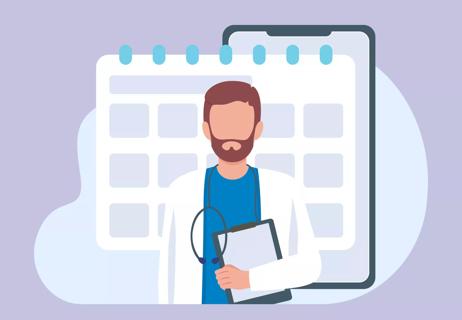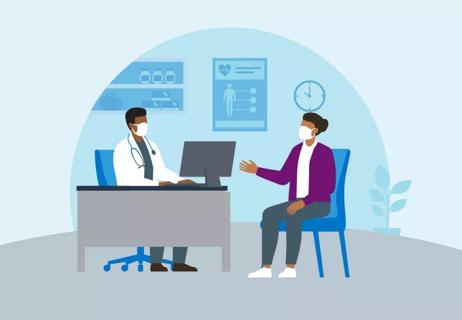An annual physical exam is important for many reasons, including your chance to ask questions

You usually call your doctor when you feel sick or when something’s wrong. So, the idea of visiting them when you feel OK might seem counterintuitive. But seeing your primary care provider on the regular can benefit you in ways you might not realize. Think of your provider as your partner in your long-term health.
Advertisement
Cleveland Clinic is a non-profit academic medical center. Advertising on our site helps support our mission. We do not endorse non-Cleveland Clinic products or services. Policy
“You need a trusted primary care provider that you can talk to about your concerns — whether they are mental health needs or changes in your family history or any other health issues that come up,” says family medicine physician Neha Vyas, MD.
In addition, the actual physical exam serves as a wellness check as you touch base with your doctor, address any health issues and talk about preventive measures for your future.
“It’s a chance for the doctor to reconnect with their patient and for you, the patient, to reconnect with your physician,” adds family medicine physician Daniel Allan, MD.
Dr. Allan and Dr. Vyas talk to us about the importance of an annual exam, including how often you need one and what to expect.
Have a nagging health question that doesn’t rise to the level of needing its own appointment? Your physical exam is the perfect time to ask your healthcare provider anything that’s been on your mind.
“It’s a chance to come in and bring up things that are bugging you,” Dr. Allan says, “whether it’s a lingering health issue or something you read that you want your doctor’s opinion on.”
Physical exams provide an opportunity to check in on your overall health, which can also help you forge a relationship with your primary care provider. And that comes in handy for the times when something actually is wrong.
Advertisement
Your primary care provider might be a physician, a physician assistant or a nurse practitioner. They’re trained to spot and manage health issues, including chronic diseases like heart disease, diabetes and lung disease. These are some of the biggest health threats in the U.S. and worldwide — and they often hide in plain sight.
“Catching and treating diseases early leads to better health outcomes,” Dr. Vyas says.
Your provider can also suggest lifestyle changes to keep you healthy or address any nagging concerns you’ve put off, like an achy joint or an odd-looking mole you’ve been meaning to have looked at.
“Even if you’re young and healthy, it’s important to establish care with a provider so you have someone who knows your history to go to when something comes up,” she adds.
Opinions vary, even among medical professionals, about how often you need a physical exam. There isn’t an exact formula for how often you should see your primary care provider when you’re feeling good. Maybe it’s every year or maybe it’s more or less often. That’s something you and your provider can decide together based on your age and your unique health history, risks and needs.
If you’re healthy and in your 20s and 30s, Dr. Allan says you can come in every two years or so. But beyond that, you should make it an annual habit.
“Getting a physical should be a regular occurrence as you hit age 40 and up,” he advises.
Your yearly check-up with your primary care provider will combine two main factors: talking through your recent health history, changes or concerns, as well as a physical exam.
Each appointment is unique, depending on the provider and patient.
“We do a basic exam on everybody,” Dr. Allan says, “but there are some specific things we adjust depending on each patient.” He explains what you can likely expect from your annual physical.
First, this is a good chance to brief your provider on your recent health history. Use this as an opportunity to bring up any changes in your family health history or any concerns you have. For example, if you’re a person who gets periods, have you noticed a change in your menstrual cycle? Now is the time to bring something like that up. Your provider might also ask about your exercise, smoking and drinking habits.
Next, your provider will go through a physical exam. There are a couple of basic things they can check just by observing and examining your body. Often, your body sends signals that you may not even be aware of, so a head-to-toe examination is very important.
Advertisement
They may do more, too, depending on your age and medical history.
“We tailor the exam to the patient,” Dr. Allan explains. “For example, if my patient is middle-aged or older, I’ll listen to their carotid artery for stenosis, or a buildup of plaque, which I wouldn’t do for a healthy 21-year-old who’s getting a pre-employment physical.”
What your checkup with your provider entails will vary from person to person, but you can generally expect some of these additional steps:
Your provider will use your height and weight measurement to calculate your body mass index (BMI). A high BMI is associated with an increased risk of cancer, heart disease and stroke. If you feel uncomfortable with your weight being checked or being read aloud, you can let your healthcare provider know beforehand.
Your vital signs are measurements of your body’s basic functions. Drastic changes in your body temperature, pulse or breathing rate could be signs of an underlying medical issue. A healthcare provider will take your blood pressure and pulse — sometimes, more than once, just to be sure.
“If someone has a history of abnormal blood pressure, I’ll sometimes check it again, even after the nurse has already done it,” Dr. Allan notes, “because it’s just that important.”
Advertisement
Having high blood pressure raises your risk of stroke, heart attack, kidney damage and heart failure. The good news? There are many changes you can make to your daily lifestyle to bring it into a healthy range.
Get ready to answer your doctor’s questions about your body — and though the questions may seem random, trust that they’re being asked with intention.
“I like to go through each organ system and ask questions that may trigger reminders and responses: Are you having any chest pains or shortness of breath? What color is your urine? Do you have any unusual moles?” Dr. Allan says. “Sometimes, people say, ‘Oh, yeah, I forgot. I do have that!’”
Your provider may also want to do an internal exam or sexual health screening. If you’re a person with a vagina, a pelvic exam and/or Pap test might also be part of your physical. These exams look for signs of cervical cancer, HPV (human papillomavirus) or any other gynecological issues. But not all primary care providers do these types of exams and may refer you to an Ob/Gyn instead for a well-woman exam.
If you’re someone with a prostate, your provider might do additional exams to check for signs of testicular cancer, prostate cancer or hernia.
Advertisement
Depending on the conversation you have during your appointment, your provider might also order blood tests to check your cholesterol and electrolyte or blood sugar levels, for example. Blood tests can shed light on how well your organs are working and are helpful in diagnosing diseases like diabetes, cancer and heart disease.
This appointment is a chance to open the lines of communication with your provider, so they’re likely to ask some questions designed to get you more comfortable sharing.
“I start with an open-ended approach to give patients a chance to voice any issues, concerns or questions they have so they feel like they have an opportunity to get out in the open anything they want to discuss,” Dr. Allan says.
While not all providers take this approach, you should still expect to touch on some of the following questions and topics:
It may feel tempting to fudge the truth, but your provider isn’t here to judge. Be honest with them about alcohol and tobacco use, including frequency and any perceived problems.
Getting a physical is, in part, about helping you prepare for a healthy future, which includes keeping an eye on your genetic predisposition to medical issues. If your biological mother is dealing with high cholesterol or your sibling was recently diagnosed with cancer, let your provider know.
“I keep a problem list for each patient, where I keep track of family health issues,” Dr. Allan notes. “That way, when the patient comes in, we can look through that list and address anything we know we need to keep an eye on.”
To get a feel for your mental health status, your provider may ask questions like, “Are you still working?” and “How has your family been?” These questions will help them gauge your current stage of life and mental state, including whether you have the capacity to make major health changes, if needed.
“The answers to these questions give me a sense of my patient’s ability to invoke any changes to their own health right now,” Dr. Allan says. “For example, if I learn that a patient is currently taking care of their dying mother, I know they’re probably not going to be able to manage any other major changes at the moment.”
Your annual physical doesn’t have to be stress-inducing. For the most part, your healthcare provider will lead the way. But it’s also good to take a few simple steps to prepare yourself for your physical to ensure that you get the most out of your appointment.
Your provider may give you guidance for healthy living as it relates to any issues you’re experiencing. And your after-visit summary (typically available both in print and online, if your provider uses an electronic medical record that you can access) will recap what you’ve discussed during the visit, including:
“Even if a patient isn’t experiencing current, active health issues, the physical exam gives us an opportunity to determine what might happen in the future,” Dr. Allan states, “so we can prepare for it and address it later.”
This visit sets the groundwork for following up with any other health concerns or questions you may have. Your primary care provider will keep track of everything you discussed and will keep a record of it so they have an overall picture of your health — not just right now, but across the years. That means that what you discuss at this appointment can inform your conversations and goals for future appointments — keeping you on a healthy track for the long term.
Learn more about our editorial process.
Advertisement

Signs are what your provider can see, but symptoms are what you feel or experience

Screenings and tests done during a wellness check can uncover hidden health issues

From odors to colors, it’s more than OK to ask your doctor these questions

This iconic medical tool has an enduring role

Simple tips to make your visit more effective

Tips to help you get the most from your visit

What you really want to know about what's going on down there

Prescription oral antivirals are your best bet, but OTC creams can help, too

If you’re feeling short of breath, sleep can be tough — propping yourself up or sleeping on your side may help

If you fear the unknown or find yourself needing reassurance often, you may identify with this attachment style

If you’re looking to boost your gut health, it’s better to get fiber from whole foods